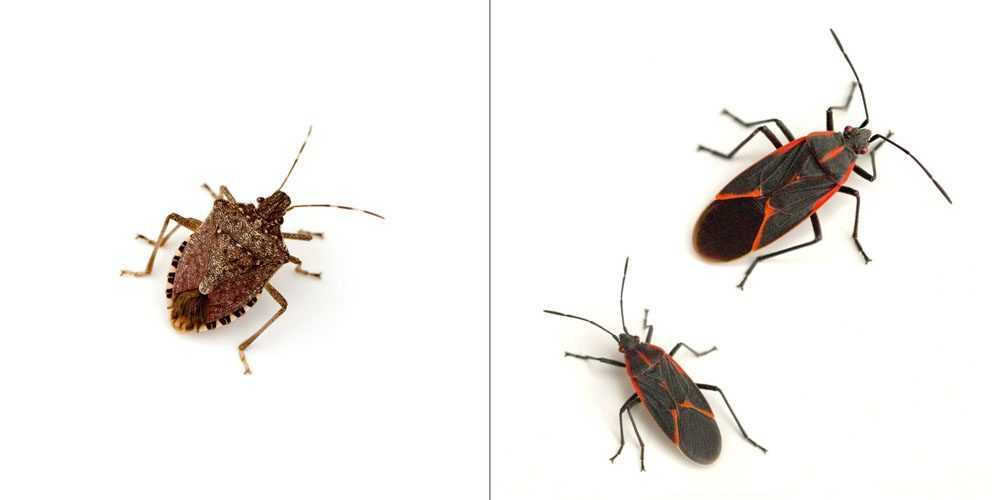Stink Bugs and Boxelder Bugs: Are you seeing them more in the fall?
Cooler weather sends stink bugs and boxelder bugs exploring for shelter
Being a certified entomologist is not necessary to know that the cooler seasons give insects a clear-cut agenda. Like many insects, stink bugs and boxelder bugs seek shelter when the season changes from summer to fall. Typically during spring and summer months, stink bugs and boxelder bugs spend their time outdoors, often high in treetops, away from normal human activity. It’s the drop in temperatures that the fall season brings that start these insects looking for warmth and shelter to ride the winter out.
What a traveling little stink bug can cause
Without knowing it, insects hitch rides aboard cargo ships and travel to the United States from overseas. Stink bugs arrived from Asia in the 80s and landed in U. S. cornfields. These insects have caused the vast destruction of local crops upon their arrival. Today there are more than a thousand various species of stink bugs in the world. The most common of these bugs here in the U. S. is the Halyomorpha halys (brown marmorated stink bugs), and the Acrosternum hilare (green stink bugs). Their backs look like shields and easily blend into their environment. These bugs release an odor that does stink if they feel threatened by an adversary. Despite the fact that these bugs require diligent pest control, they are not harmful to humans or their homes.
The diet of a stink bug
The majority of stink bugs feed on plants. The young stink bugs feed on weeds and grasses, as they grow into adulthood they migrate into residential landscapes, orchards, or field crops. These bugs love feasting on beans, pecans, corn, peppers, apples, berries, cotton, corn, sorghum, and ornamental plants. When this bug gorges on his fruit, he leaves his saliva behind, which marks the fruit, leaving it scarred and unfit for sale. This insect is known to also spread disease. Here in the Portland and Vancouver areas homeowners rarely see stink bugs in the summer months as they feed high in tree foliage.
Another stinky bug, the boxelder
Boxelder bugs are another type of bug that uses their stink to protect themselves. They are not harmful to humans but more of an annoyance. Boxelder bugs have deep brown outer wings with red markings. These bugs feed on seedpods of seed-bearing boxelder trees as well as their flowers and leaves. Besides the boxelder tree, boxelder bugs also feed on ash and maple trees. They also have been known to eat plants bearing plums, grapes, pears, peaches, cherries, apples, and almonds. The fruit of these trees ends up deformed from the boxelder bugs’ perforations.
Look for shelter in the fall
Come September and October, as the cooler weather draws near, diligent pest control is advised to control these bugs. Adult stink and boxelder bugs will search for dry spaces in the crevices and cracks in walls, in the moldings around windows, cracks in house foundations. As the weather turns colder, these bugs will seek out any crack and crevice to gain access to the warmth of there interior of your home.
Stink and boxelder bugs also seek shelter in hollow tree trunks, under rocks, and under woodpiles to live out the winter. If these bugs are evident in your home in the fall, come spring you’ll start seeing them again as they emerge from winter hiding to once again explore the outdoors.
Avoid an infestation by winterizing the yard and home
Inspecting gardens and homes determines what steps are necessary to prevent a massive infestation of stink or boxelder bugs. Cleaning out all the debris around the foundation of the house, corners of fences, decorative rocks, old piles of wood, and patio furniture helps to eliminate hiding places for bugs seeking refuge from the cold. On windows and doors replace torn screens as well as caulk around the molding of the windows, vents, cracks in stucco and bricks restricting additional hiding places and protection for bugs from the winter chill.
Sometimes no matter what you do as a homeowner, stink and boxelder bugs will be a problem. Sealing up cracks around roof soffits, windows, siding, and foundations can go a long way in preventing these insects from invading the interior of your home. Another helpful and most times successful tactic is to enlist the help and expertise of an experienced pest control company. Pest control companies with experienced technicians can offer expert advice on controlling these bugs through an effective treatment plan to keep your home protected. Call us today to get an experienced PURCOR technician to your Northwest home or business ASAP!
"*" indicates required fields
"*" indicates required fields




